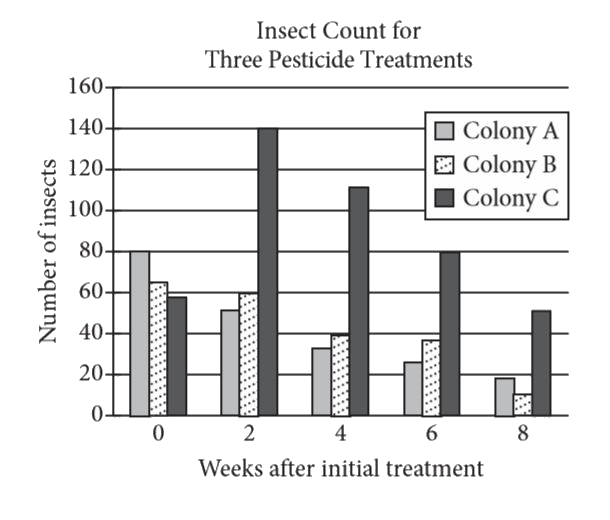The number of mice in a certain colony is shown by the formula above, such that n is the number of mice and t is the time, in months, since the start of the colony. IF 2 years have passed since the start of the colony, how many mice does the colony contain now?
The correct Answer is:3072
Step by step video, text & image solution for n=12times2^(t/3) The number of mice in a certain colony is shown by the formula above, such that n is the number of mice and t is the time, in months, since the start of the colony. IF 2 years have passed since the start of the colony, how many mice does the colony contain now? by Maths experts to help you in doubts & scoring excellent marks in Class 12 exams.
Topper's Solved these Questions
- BOOK - PRINCETONCHAPTER - GRID-INSEXERCISE - Grid-In Drill 1: No Calculator Section4videos
GRID-INS
- BOOK - PRINCETONCHAPTER - GEOMETRYEXERCISE - Geometry Drill 1: No calculator Section4videos
GEOMETRY
- BOOK - PRINCETONCHAPTER - MATH PRACTICE SECTION -1EXERCISE - MATHEMATICS TEST59videos
MATH PRACTICE SECTION -1
Similar Questions
A person starts writing numbers from 1 to n in a row such that ith number is written i2 times then find 500th digit from the starting.
View SolutionGiven a starting population of 100 bacteria, the formula b(t)=100(2t) can be used to determine the number of bacteria, b, after t periods of time. If each time period is 15 minutes long, how many minutes will it take for the population of bacteria to reach 51,200?
View Solution
Knowledge Check
- Question 1 - Select One
En=−(2,18×10−18)Z2n2
Electrons follow paths, called orbits around the nucleus of an atom. According to the Bohr model, the energy in joules of an atom's nth orbit containing a single electron is given by the formula shown above, where Z is the atomic number of the atom and n is the orbit number. Which of the following equations gives the atomic number of an atom given the energy of its nth orbit (assuming there is a single electron is that orbit)?AZ=109√−n2En2.18BZ=1109√−n2En2.18CZ=109√−2.18Enn2DZ=1109√−2.18Enn2 - Question 2 - Select One
The number of bacteria colonies h hours after the beginning of an experiment is given by the function C(h)=3h−2h+20. What does the number 20 represent in the function?
AThe final rate of growth, in colonies per hour.BThe initial rate of growth, in colonies per hourCOne less than the initial number of bacteria coloniesDOne more than the final number of bacteria colonies. - Question 3 - Select One
Miriam and Jessica are growing bacteria in a laboratory. Miriam uses the growth function f(t)=n2t to model her experiment while Jessica uses the function g(t)=(n2)4t to model her experiment. In each case, n represents the initial number of bacteria, and t is the time, in hours. If Miriam starts with 6 bacteria, how many bacteria should Jessica start with to achieve the same growth over time?
A32B16C8D4
A botanist is cultivating a rare species of plant in a controlled environment and currently has 3000 of these plants. The population of this species that the botanist expects to grow next year, Nnext year, can be estimated from the number of plants this year, Nthis year, by the equation below.
Nnext year=Nthis year+0.2(Nthis year)(1−Nthis yearK)
The constant K in this formula is the number of plants the environment is able to support.
The botanist would like to increase the number of plants that the environment can support so that the population of the species will increase more rapidly. If the botanist’s goal is that the number of plants will increase from 3000 this year to 3360 next year, how many plants must the modified environment support?View Solution
Three colonies of insects were each treated with a different pesticide over an 8-week period to test the effectiveness of the three pesticides. Colonies A, B, and C were treated with Pesticides A, B, and C, respectively. Each pesticide was applied every 2 weeks to one of the three colonies over the 8-week period. The bar graph above shows the insect counts for each of the three colonies 0, 2, 4, 6, and 8 weeks after the initial treatment.
Of the following, which is closest to the ratio of the total number of insects in all three colonies in week 8 to the total number of insects at the time of initial treatment?View SolutionThe weight W of a certain stock of fish is given by W = nw, where n is the size of stock and w is the average weight of a fish. If n and w change with time t as n = 2t2+3 and w=t2−t+2, then the rate of change of W with respect to t at t = 1, is
View SolutionThe customer service department of a wireless cellular provider has found that on Wednesdays, the polynomial funciton C(t)=−0.0815t4+t3+12t approximates the number of calls received by any given time, where t represents the number of hours that have passed during the workday. Based on this function, how many calls can be expected by the end of one 10-hour workday ?
View SolutionA number equal to 2 times the mean and with a frequency equal to k is inserted in a data having n observation. If the new mean is 43 times the old mean, then the value of kn is
View Solution
